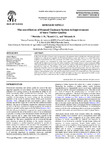The contribution of Framed Chainsaw System to Improvement of Sawn Timber Quality
| dc.contributor.author | Muthike, G.M | |
| dc.contributor.author | Kanali, C.L. | |
| dc.contributor.author | Shitanda, Douglas | |
| dc.date.accessioned | 2019-10-01T10:07:12Z | |
| dc.date.available | 2019-10-01T10:07:12Z | |
| dc.date.issued | 2013 | |
| dc.identifier.issn | 0975-833X | |
| dc.identifier.uri | http://ir.mksu.ac.ke/handle/123456780/4890 | |
| dc.description.abstract | In this study, the effect of framed chain sawing system with optimized chain on timber size uniformity and surface roughness was analyzed and compared with the freehand chainsaw system and band saw as control. The surface roughness of sawn timber from three commonly sawn timber species (Eucalyptus saligna, Grevillea robusta and Prosopis juliflora) was determined by stylus tracer approach. Freehand chainsaw produced timber with significantly the highest size deviation and surface roughness, while framed chainsaw using an optimized felling chain produced timber with more uniform sizes and smoother surfaces which did not significantly differ from that produced by a band saw. The findings of this study concluded that, the use of the frame on the chainsaw effectively control the chain to saw timber around the pre-set size thus producing timber with more uniform sizes | en_US |
| dc.language.iso | en_US | en_US |
| dc.publisher | International Journal of Current Research | en_US |
| dc.subject | Timber | en_US |
| dc.subject | Surface quality | en_US |
| dc.subject | Roughness | en_US |
| dc.subject | On-farm trees | en_US |
| dc.subject | Framed chainsaw | en_US |
| dc.title | The contribution of Framed Chainsaw System to Improvement of Sawn Timber Quality | en_US |
| dc.type | Article | en_US |
Files in this item
This item appears in the following Collection(s)
-
School of Engineering and Technology [116]
Scholarly Articles by Faculty & Students in School of Engineering and Technology

